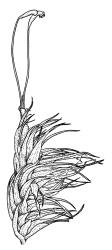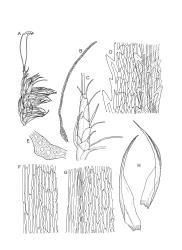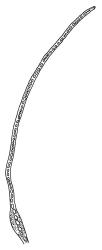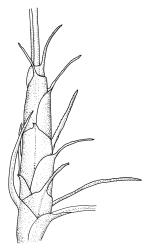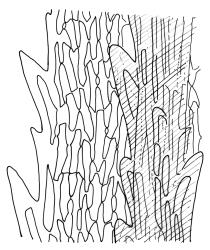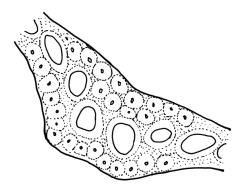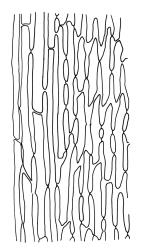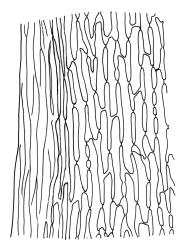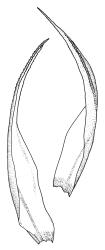- ≡ Dicranum plurisetum (Dixon) Fife, Bryologist 98: 315 (1995)
- = Dicranum pallidosplendens Müll.Hal., Gen. Musc. Frond. 290 (1900) nom. inval., nom. nud.
Plants robust, pale yellow-green or white-green and dull when fresh, becoming gold-brown in older dried specimens, forming cushions or turves. Stems (30–)50–75(–95) mm, usually branched by forking, in cross-section with 2–3 layers of thick-walled cortical cells and an ill-defined central strand, rather sparsely matted throughout by pale brown or nearly white rhizoids. Leaves usually falcate-secund, not or weakly plicate when fresh, becoming moderately plicate to mid leaf when dry, not or rarely weakly rugose, ovate-lanceolate and ± narrowed to a clasping insertion, sharply spinose-serrate in upper ⅓ or less, 8–9(–10) × (1.3–)1.4–1.5 mm (under cover slip), subtubulose, plane at margins; mid laminal cells elongate and irregular, (45–)60–105(–120) × 8–10(–15) µm and 5–12:1, thick-walled and highly porose, with elongate cells extending ± to apex; juxtacostal cells at mid leaf not differentiated; border well defined and extending from just above the alar group to serrations (usually c. ¾ leaf length), 6–8 cells and c. 20–35(–60) µm wide at mid leaf; cells of leaf base becoming longer (–150 or occasionally 180 µm) but otherwise as those of mid lamina; alar cells abruptly differentiated, unistratose, extending c. ½ to costal base and c. (6–)8–10 cells up the margin, inflated, yellow or brown, firm-walled, the largest c. 70 × 35 µm. Costa narrow, occupying c. 1/20 of widest part of leaf base, the abaxial surface in upper ⅓–½ bearing rows of short spines (obvious under hand lens), in cross-section (at mid leaf) lacking wings, with a median layer of c. 6–8 guide cells and abaxial and adaxial stereid groups which extend the width of the costa (or sometimes with 1–3 isolated larger cells among abaxial stereid group).
Pseudautoicous. Perichaetial leaves sheathing (to c. ⅓ the seta length) and strongly concave, abruptly tapered from an obovate or elliptic base to an obtuse or rounded apex, with costa extremely weak and often vanishing in leaf base, long excurrent to form a long and slender arista that is usually c. ⅕ the length of the leaf base. Dwarf males gemmiform, c. 0.35 mm long, embedded in rhizoids of sterile or ♀ plants. Setae aggregated, 1–6(–9) per perichaetium, 8–15 mm, straight, not twisted, pale brown; capsules exserted, curved, cylindric, 2.5–2.8 mm, mostly strumose, smooth when moist, constricted below the mouth and mostly sulcate when dry; exothecial cells firm-walled and oblong-hexagonal; stomata restricted to neck, superficial; annulus weakly differentiated, not revoluble; operculum curved-rostrate from a conic base, ± equal to the capsule. Peristome teeth inserted at mouth, red-brown, split ½–⅗ to base into segments of unequal width (and often with 1–2 elongate perforations at base of division), c. 640 × 100 µm, papillose-striolate in lower ½–⅔, baculate near apex. Calyptra cucullate, smooth. Spores spherical, 16–19 µm, nearly smooth.
Dixon 1913, pl. 2, figs 7a, 7c, 7d and pl. 3, fig. 7b; Klazenga 2003, fig. 25; Malcolm & Malcolm 2003, p. 22; Malcolm & Malcolm 2006, pp. 90, 149, 195.
When fresh the dull white-green plants of D. plurisetum strongly contrast with the shiny yellow-green D. robustum, but this colour difference is lost in dry, especially older, herbarium material. The leaves of D. plurisetum are obviously spined in two ranks on the abaxial surface of the upper costa, and the plants are also more compact and neater in appearance, in part due to the shorter leaves and the tendency of the stems to branch a few millimetres below the apex. When fresh the weak plications of the lower half of the leaf of D. plurisetum can be inconspicuous, but in dried material these plications become more prominent and are visible under the hand-lens. The leaf plications, the spinose upper costae, the sharply spinose-serrate upper leaf margins, and a stronger border (all visible under a hand-lens) all serve to distinguish D. plurisetum from D. robustum.
Dicranoloma plurisetum is frequently confused with D. dicarpum and D. platycaulon, which are both similar in colour (white-green or pale yellow-green and dull) when fresh. In the field the shorter, broader leaves with weaker laminal plications and wider laminae distinguish it from D. dicarpum; D. plurisetum also tends to grow in damper and more deeply shaded sites. The plications of the lower leaves, the lack of laminal undulations, and the more sharply spinose-serrate teeth of the upper leaf margins are normally sufficient to distinguish D. plurisetum from D. platycaulon. Other differences are detailed under those species. Occasional specimens of D. plurisetum (e.g., P.J. Brownsey s.n. from Waipoua Forest, WELT M030059) can exhibit distinct leaf undulations; such material can most easily be separated from D. platycaulon on the basis of the upper laminal cell outlines. Confusion when sterile is also possible with D. fasciatum, but that is generally a much smaller plant than D. plurisetum.
NI: N Auckland (Waipoua Forest, Waitakere Range), S Auckland, Gisborne, Hawke’s Bay, Taranaki, Wellington; SI: Nelson, Marlborough, Canterbury, Westland, Otago, Southland; St.
Endemic.
On duff, most often in forest with one or more species of southern beech; less often in forest lacking southern beech or in subalpine or other scrub. This species is best developed on steep soil banks, such as shaded, moist track margins, and can form turves up to several square metres in extent. Occurring also on soil or rock hummocks, exposed tree roots, and occasionally on rotten logs or tree trunks. On hummocks it can form compact cushions to at least 40 cm diameter. Dicranoloma plurisetum is a common and widespread forest floor species, most abundant in areas of higher rainfall; it nearly always grows in association with D. robustum. Other commonly associated species include Dendroligotrichum dendroides, Dicranoloma billardierei, and Ptychomnion aciculare, as well as Bazzania and Lepidozia spp. On the South I. this species is most abundant west of or near the Main Divide. Only rarely occurring above the tree line. Ranging from 60 m (Rimutaka Range, Wellington L.D.) to 1300 m (Mt Maungapōhatu, Gisborne L.D.) on the North I., and from near sea level (several localities) to at least 1250 m (near Lake Harris, Southland L.D.) on the South I.
A more detailed description of D. plurisetum is provided by Klazenga (2003).
Material of Dicranum pallidosplendens Müll.Hal., nom. nud. (R. Helms s.n. from the Paparoa Range, NY!) is referable to D. plurisetum.



